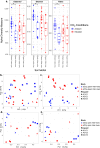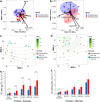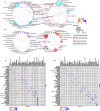Elevated atmospheric CO2 concentrations caused a shift of the metabolically active microbiome in vineyard soil
- PMID: 36809988
- PMCID: PMC9942357
- DOI: 10.1186/s12866-023-02781-5
Elevated atmospheric CO2 concentrations caused a shift of the metabolically active microbiome in vineyard soil
Abstract
Background: Elevated carbon dioxide concentrations (eCO2), one of the main causes of climate change, have several consequences for both vine and cover crops in vineyards and potentially also for the soil microbiome. Hence soil samples were taken from a vineyard free-air CO2 enrichment (VineyardFACE) study in Geisenheim and examined for possible changes in the soil active bacterial composition (cDNA of 16S rRNA) using a metabarcoding approach. Soil samples were taken from the areas between the rows of vines with and without cover cropping from plots exposed to either eCO2 or ambient CO2 (aCO2).
Results: Diversity indices and redundancy analysis (RDA) demonstrated that eCO2 changed the active soil bacterial diversity in grapevine soil with cover crops (p-value 0.007). In contrast, the bacterial composition in bare soil was unaffected. In addition, the microbial soil respiration (p-values 0.04-0.003) and the ammonium concentration (p-value 0.003) were significantly different in the samples where cover crops were present and exposed to eCO2. Moreover, under eCO2 conditions, qPCR results showed a significant decrease in 16S rRNA copy numbers and transcripts for enzymes involved in N2 fixation and NO2- reduction were observed using qPCR. Co-occurrence analysis revealed a shift in the number, strength, and patterns of microbial interactions under eCO2 conditions, mainly represented by a reduction in the number of interacting ASVs and the number of interactions.
Conclusions: The results of this study demonstrate that eCO2 concentrations changed the active soil bacterial composition, which could have future influence on both soil properties and wine quality.
Keywords: Active soil bacterial community; CO2; Carbon cycle; FACE; Nitrogen cycle; Vineyard; mRNA quantification; rRNA.
© 2023. The Author(s).
Conflict of interest statement
The authors declare that they have no competing interests.
Figures







References
-
- Wohlfahrt Y, Smith JP, Tittmann S, Honermeier B, Stoll M. Primary productivity and physiological responses of Vitis vinifera L. cvs. under Free Air Carbon dioxide Enrichment (FACE). Eur J Agron. 2018;101 February:149–62. 10.1016/j.eja.2018.09.005.
-
- da Silva JR, Patterson AE, Rodrigues WP, Campostrini E, Griffin KL. Photosynthetic acclimation to elevated CO2 combined with partial rootzone drying results in improved water use efficiency, drought tolerance and leaf carbon balance of grapevines (Vitis labrusca). Environ Exp Bot. 2017;134:82–95.
-
- Edwards EJ, Unwin D, Kilmister R, Treeby M, Ollat N. Multi-seasonal effects of warming and elevated CO2 on the physiology, growth and production of mature, field grown, Shiraz grapevines. J Int des Sci la Vigne du Vin. 2017;51:127–132.
-
- Kizildeniz T, Pascual I, Irigoyen JJ, Morales F. Using fruit-bearing cuttings of grapevine and temperature gradient greenhouses to evaluate effects of climate change (elevated CO2 and temperature, and water deficit) on the cv. red and white Tempranillo. Yield and must quality in three consecutive growin. Agric Water Manag. 2018;202:299–310. 10.1016/j.agwat.2017.12.001.
-
- Wohlfahrt Y, Tittmann S, Schmidt D, Rauhut D, Honer B, Stoll M. The effect of elevated CO2 on berry development and bunch structure of Vitis vinifera L. cvs. Riesling and cabernet sauvignon. Appl Sci. 2020;10:2486. 10.3390/app10072486.
Publication types
MeSH terms
Substances
LinkOut - more resources
Full Text Sources

